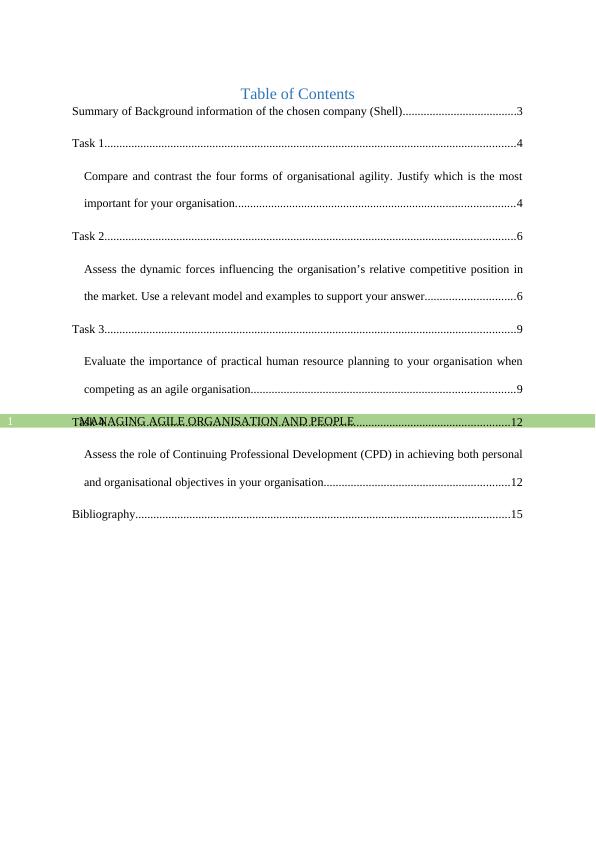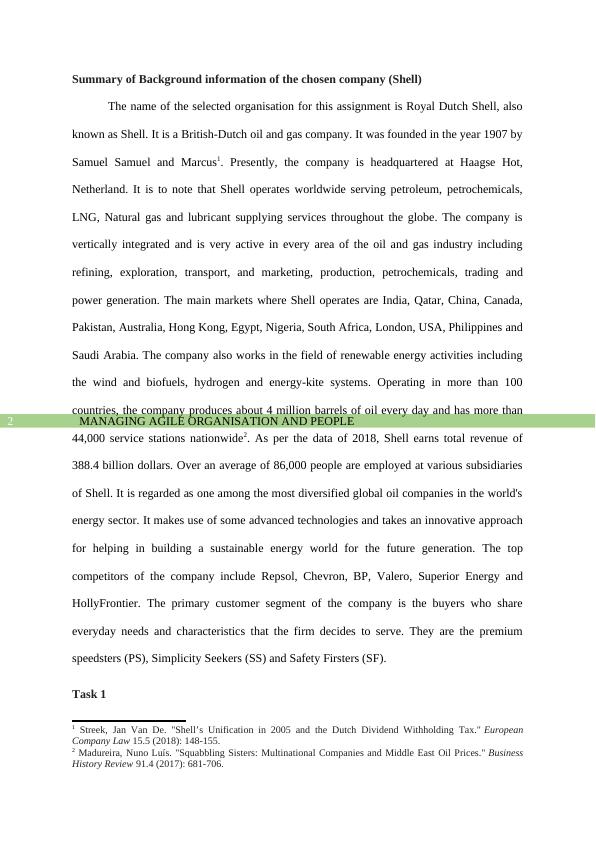Managing Agile Organisation and People
Added on 2022-11-12
17 Pages4918 Words176 Views
Running head: MANAGING AGILE ORGANISATION AND PEOPLE
MANAGING AGILE ORGANISATION AND PEOPLE
Name of the Student:
Name of the University:
Author note:
MANAGING AGILE ORGANISATION AND PEOPLE
Name of the Student:
Name of the University:
Author note:

MANAGING AGILE ORGANISATION AND PEOPLE1
Table of Contents
Summary of Background information of the chosen company (Shell)......................................3
Task 1.........................................................................................................................................4
Compare and contrast the four forms of organisational agility. Justify which is the most
important for your organisation.............................................................................................4
Task 2.........................................................................................................................................6
Assess the dynamic forces influencing the organisation’s relative competitive position in
the market. Use a relevant model and examples to support your answer..............................6
Task 3.........................................................................................................................................9
Evaluate the importance of practical human resource planning to your organisation when
competing as an agile organisation........................................................................................9
Task 4.......................................................................................................................................12
Assess the role of Continuing Professional Development (CPD) in achieving both personal
and organisational objectives in your organisation..............................................................12
Bibliography.............................................................................................................................15
Table of Contents
Summary of Background information of the chosen company (Shell)......................................3
Task 1.........................................................................................................................................4
Compare and contrast the four forms of organisational agility. Justify which is the most
important for your organisation.............................................................................................4
Task 2.........................................................................................................................................6
Assess the dynamic forces influencing the organisation’s relative competitive position in
the market. Use a relevant model and examples to support your answer..............................6
Task 3.........................................................................................................................................9
Evaluate the importance of practical human resource planning to your organisation when
competing as an agile organisation........................................................................................9
Task 4.......................................................................................................................................12
Assess the role of Continuing Professional Development (CPD) in achieving both personal
and organisational objectives in your organisation..............................................................12
Bibliography.............................................................................................................................15

MANAGING AGILE ORGANISATION AND PEOPLE2
Summary of Background information of the chosen company (Shell)
The name of the selected organisation for this assignment is Royal Dutch Shell, also
known as Shell. It is a British-Dutch oil and gas company. It was founded in the year 1907 by
Samuel Samuel and Marcus1. Presently, the company is headquartered at Haagse Hot,
Netherland. It is to note that Shell operates worldwide serving petroleum, petrochemicals,
LNG, Natural gas and lubricant supplying services throughout the globe. The company is
vertically integrated and is very active in every area of the oil and gas industry including
refining, exploration, transport, and marketing, production, petrochemicals, trading and
power generation. The main markets where Shell operates are India, Qatar, China, Canada,
Pakistan, Australia, Hong Kong, Egypt, Nigeria, South Africa, London, USA, Philippines and
Saudi Arabia. The company also works in the field of renewable energy activities including
the wind and biofuels, hydrogen and energy-kite systems. Operating in more than 100
countries, the company produces about 4 million barrels of oil every day and has more than
44,000 service stations nationwide2. As per the data of 2018, Shell earns total revenue of
388.4 billion dollars. Over an average of 86,000 people are employed at various subsidiaries
of Shell. It is regarded as one among the most diversified global oil companies in the world's
energy sector. It makes use of some advanced technologies and takes an innovative approach
for helping in building a sustainable energy world for the future generation. The top
competitors of the company include Repsol, Chevron, BP, Valero, Superior Energy and
HollyFrontier. The primary customer segment of the company is the buyers who share
everyday needs and characteristics that the firm decides to serve. They are the premium
speedsters (PS), Simplicity Seekers (SS) and Safety Firsters (SF).
Task 1
1 Streek, Jan Van De. "Shell’s Unification in 2005 and the Dutch Dividend Withholding Tax." European
Company Law 15.5 (2018): 148-155.
2 Madureira, Nuno Luís. "Squabbling Sisters: Multinational Companies and Middle East Oil Prices." Business
History Review 91.4 (2017): 681-706.
Summary of Background information of the chosen company (Shell)
The name of the selected organisation for this assignment is Royal Dutch Shell, also
known as Shell. It is a British-Dutch oil and gas company. It was founded in the year 1907 by
Samuel Samuel and Marcus1. Presently, the company is headquartered at Haagse Hot,
Netherland. It is to note that Shell operates worldwide serving petroleum, petrochemicals,
LNG, Natural gas and lubricant supplying services throughout the globe. The company is
vertically integrated and is very active in every area of the oil and gas industry including
refining, exploration, transport, and marketing, production, petrochemicals, trading and
power generation. The main markets where Shell operates are India, Qatar, China, Canada,
Pakistan, Australia, Hong Kong, Egypt, Nigeria, South Africa, London, USA, Philippines and
Saudi Arabia. The company also works in the field of renewable energy activities including
the wind and biofuels, hydrogen and energy-kite systems. Operating in more than 100
countries, the company produces about 4 million barrels of oil every day and has more than
44,000 service stations nationwide2. As per the data of 2018, Shell earns total revenue of
388.4 billion dollars. Over an average of 86,000 people are employed at various subsidiaries
of Shell. It is regarded as one among the most diversified global oil companies in the world's
energy sector. It makes use of some advanced technologies and takes an innovative approach
for helping in building a sustainable energy world for the future generation. The top
competitors of the company include Repsol, Chevron, BP, Valero, Superior Energy and
HollyFrontier. The primary customer segment of the company is the buyers who share
everyday needs and characteristics that the firm decides to serve. They are the premium
speedsters (PS), Simplicity Seekers (SS) and Safety Firsters (SF).
Task 1
1 Streek, Jan Van De. "Shell’s Unification in 2005 and the Dutch Dividend Withholding Tax." European
Company Law 15.5 (2018): 148-155.
2 Madureira, Nuno Luís. "Squabbling Sisters: Multinational Companies and Middle East Oil Prices." Business
History Review 91.4 (2017): 681-706.

MANAGING AGILE ORGANISATION AND PEOPLE3
Compare and contrast the four forms of organisational agility. Justify which is the most
important for your organisation.
- According to Cegarra-Navarro, Soto-Acosta and Wensley, organisational agility refers to
the capacity of a company to rapidly change and adapt in response to the changes in the
business market3. It is a critical component required for ensuring business success. It is to
note that the four forms of organisational agility are innovator, disrupter, indifferent and
adaptive. Firstly, innovators are the ones that identify their competitive strength in
defining the new chances and opportunities and at the same time, strive for the capacity
for the movements that are linked with the greater magnitude of variety of changes at the
cost of reduced and constant change rate. The organisations that use this type of
organisational agility tend to push their importance of many change4. On the other hand,
the organisation that has the capacity of producing a heightened variety change rate but
have lower and constant magnitude of variety change are referred to as adaptive
organisations. Furthermore, disrupters are defined as the market competition utilizing
developing a capacity for overcoming the trade-offs using generating higher magnitude
and greater variety change rate. Finally, the indifferent is that form of organisational
agility where the organisation that do not get engaged in the agile-based competition
within the industry and at the same time, they do not anticipate the magnitude and the
variety change rate to be a critical property of the strategic responses. It is to note that
organisational agility is an essential element of business success. An agile organisation
have the key features and characteristics of success, systems, leadership, culture and
people5. It is to note that success is always the top of the pyramid, and it reflects all the
3 Cegarra-Navarro, Juan-Gabriel, Pedro Soto-Acosta, and Anthony KP Wensley. "Structured knowledge
processes and firm performance: The role of organizational agility." Journal of Business Research 69.5 (2016):
1544-1549.
4s Harraf, Abe et al. "Organizational agility." Journal of Applied Business Research 31.2 (2015): 675.
5 Chan, Alan TL, Eric WT Ngai, and Karen KL Moon. "The effects of strategic and manufacturing flexibilities
and supply chain agility on firm performance in the fashion industry." European Journal of Operational
Research 259.2 (2017): 486-499.
Compare and contrast the four forms of organisational agility. Justify which is the most
important for your organisation.
- According to Cegarra-Navarro, Soto-Acosta and Wensley, organisational agility refers to
the capacity of a company to rapidly change and adapt in response to the changes in the
business market3. It is a critical component required for ensuring business success. It is to
note that the four forms of organisational agility are innovator, disrupter, indifferent and
adaptive. Firstly, innovators are the ones that identify their competitive strength in
defining the new chances and opportunities and at the same time, strive for the capacity
for the movements that are linked with the greater magnitude of variety of changes at the
cost of reduced and constant change rate. The organisations that use this type of
organisational agility tend to push their importance of many change4. On the other hand,
the organisation that has the capacity of producing a heightened variety change rate but
have lower and constant magnitude of variety change are referred to as adaptive
organisations. Furthermore, disrupters are defined as the market competition utilizing
developing a capacity for overcoming the trade-offs using generating higher magnitude
and greater variety change rate. Finally, the indifferent is that form of organisational
agility where the organisation that do not get engaged in the agile-based competition
within the industry and at the same time, they do not anticipate the magnitude and the
variety change rate to be a critical property of the strategic responses. It is to note that
organisational agility is an essential element of business success. An agile organisation
have the key features and characteristics of success, systems, leadership, culture and
people5. It is to note that success is always the top of the pyramid, and it reflects all the
3 Cegarra-Navarro, Juan-Gabriel, Pedro Soto-Acosta, and Anthony KP Wensley. "Structured knowledge
processes and firm performance: The role of organizational agility." Journal of Business Research 69.5 (2016):
1544-1549.
4s Harraf, Abe et al. "Organizational agility." Journal of Applied Business Research 31.2 (2015): 675.
5 Chan, Alan TL, Eric WT Ngai, and Karen KL Moon. "The effects of strategic and manufacturing flexibilities
and supply chain agility on firm performance in the fashion industry." European Journal of Operational
Research 259.2 (2017): 486-499.

End of preview
Want to access all the pages? Upload your documents or become a member.
Related Documents
Role Of Transportation Sectorlg...
|10
|2862
|89
External Influences on Shell Petroleum Operationslg...
|9
|2192
|208
Challenges and Operations in the Oil and Gas Industrylg...
|14
|3534
|24
Marketing Mix Portfoliolg...
|13
|4421
|318
Impact of Existing Competition and Globalisation on Shell Petroleum Operationslg...
|8
|1976
|485
Enterprise Resource Planning for Shell Company: Challenges, Business Requirements and Hana Platformlg...
|12
|3589
|242
